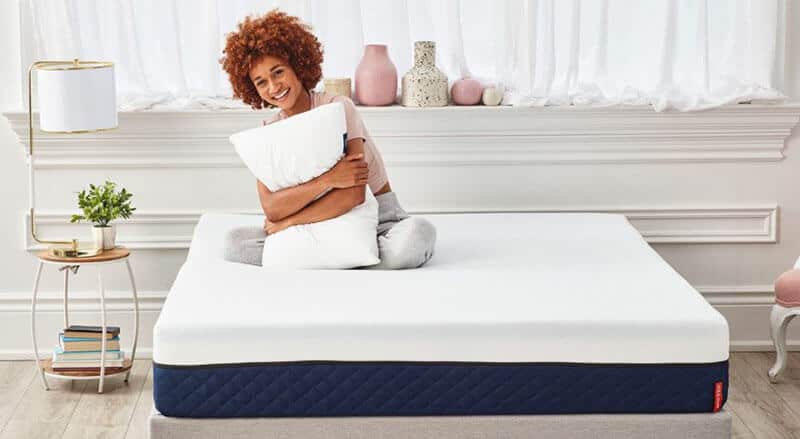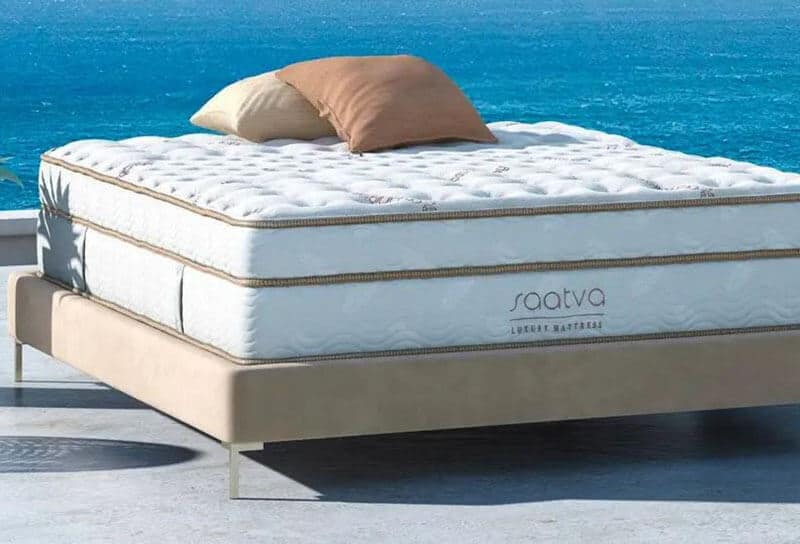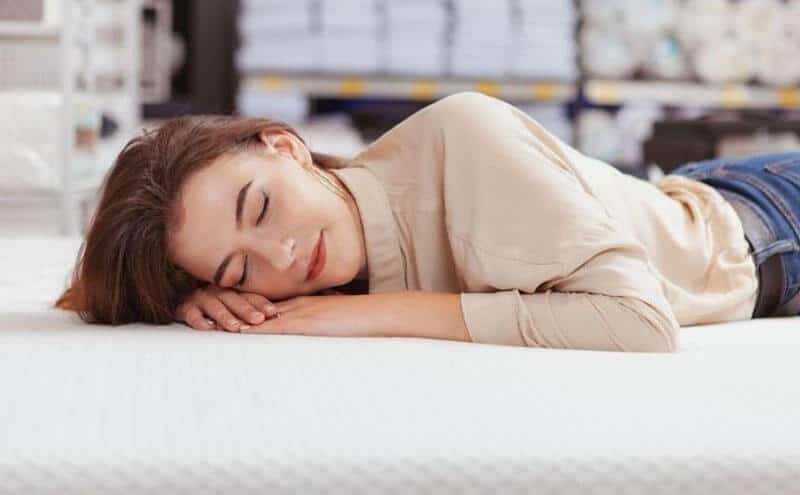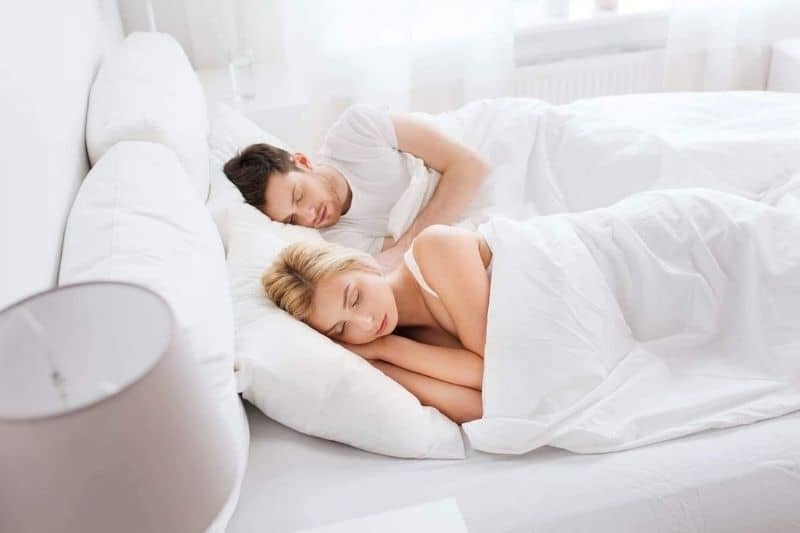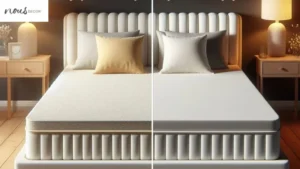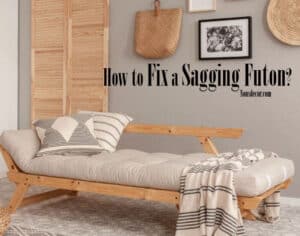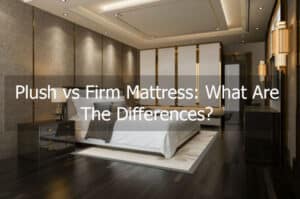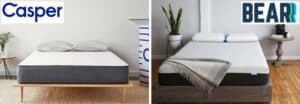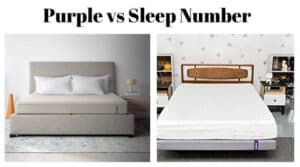Picking an ideal mattress is not simple. There are many different mattresses on the current market, and all of them include their very own set of advantages and pitfalls.
In any case, picking a brand new mattress entails many critical considerations like budget, size, durability, and kind of mattress,…
When there are many different kinds of mattresses, they could be broken up into two distinct categories: Foam vs Spring Mattress (there are a few types that include both layouts, known as hybrid mattresses).
Today, Nousdecor will compare memory foam mattresses with innerspring mattresses. We will discuss the differences and similarities between each type of mattress, their feel, and the pros and cons. This will help you decide which one is right for you.
What is a Foam Mattress?
Foam mattresses are made up of air trapped in aerated substances, rather than springs. This allows for support and bounce. There are three main types: memory foam, polyurethane foam, and foam latex.
Polyurethane Foam
The most popular foam used in mattress manufacturing is polyurethane or polyfoam. Polyurethane was first used in mattresses as an alternative to natural fibre fillings like wool and cotton in the 1950s.
It is a man-made substance derived from petroleum. It is made by mixing two chemicals, polyol (a complex version of alcohol) and isocyanates.
There are three types of polyurethane, each with different densities and grades. These differences affect the material’s performance, quality, and durability. Because the material is affordable and is easy to compress, it is often used in bed in a box mattress.
It conforms well to the body for pressure-relieving comfort. Still, it is not as flexible as memory foam or pocketed coils. It responds quickly and retains its original form back, which is unlike memory foams.
A foam mattress isolates motion better than innerspring mattresses, except if they are pocketed coils. Polyfoam, a solid and resilient foam, is used as a support core for foam mattresses. Polyfoam’s variants are also used in the base foam of spring mattresses.
Foam Latex
Foam latex can be created by airing a sap-like substance to make air bubbles. It creates a firm but buoyant support that is uniform across the entire bed. Latex is a firmer and more resilient material than memory foam. It pushes back, unlike memory foam.
This means it provides superior pressure relief and firmness. Foam latex has a greater environmental benefit than memory foam. The raw materials used are natural, and the manufacturing process can be very clean.
Natural or man-made, the best latex mattresses are available. Natural latex comes from the hevea Brasiliense rubber tree and is a milky substance. Synthetic latex is an artificial copy.
Two different methods of making latex are available: Talalay and Dunlop. Both require the addition of water or a natural vulcanizing agent. The mold is then filled with Dunlop latex. It’s then left to set, leading to it being denser at its bottom than its top.
The mold is then filled with Talalay latex, but it only partially fills. The mold is vacuumed to remove air, and the foam expands to fill it. Talalay latex can then be frozen to maintain its consistency and shape. Talalay latex can be more expensive but is considered a modern method of making foam mattresses.
Memory Foam
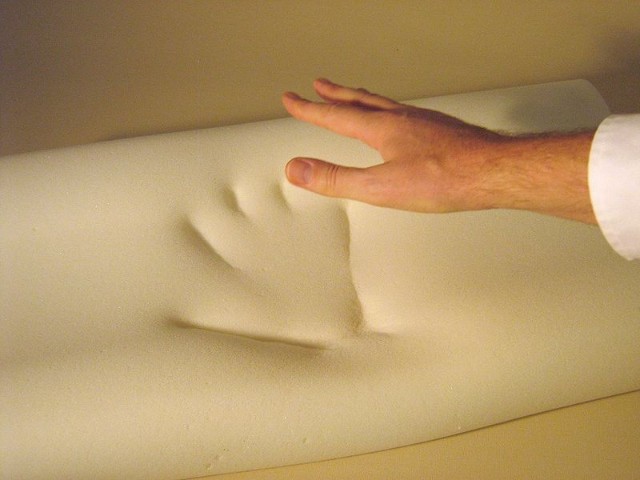
Memory foam is created by treating polyurethane foam using substances to boost its density and viscosity. Memory foam’s viscoelastic nature enables it to mold to your body while providing pressure relief. Memory foam, also called viscoelastic foam, is temperature and pressure-sensitive.
If you lie memory foam mattress, your body weight and temperature soften the foam-forming about your body like a hug. The foam distributes weight on the sleeping surface, relieving your stress points.
Everybody will get aid as the contouring foam molds to your curves, making memory foam mattress a fantastic solution for relieving back pain or joint pains. If you’re a rear or side sleeper, a memory foam mattress provides natural spinal alignment and improved lumbar support.
Kinds of Memory Foam
Memory foam beds react to your body pressure and heat, but they also tend to trap warmth. Some producers include cooling features such as gel, plant oils, copper, or graphite to conquer heat retention.
Conventional Memory Foam
Memory foam is more open-cell with its nature, but a few companies expand the tissues to get much superior venting. This combats the warmth retention issue.
Gel Memory Foam
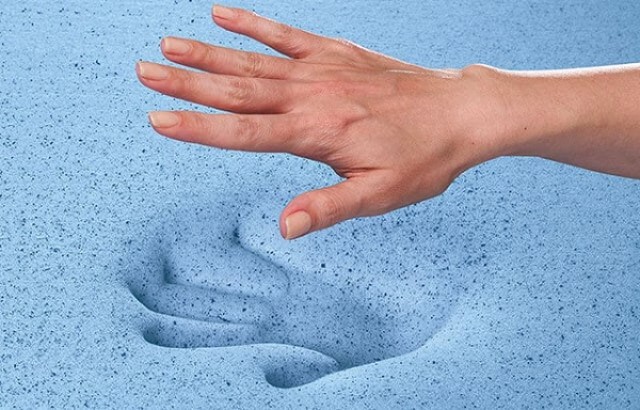
Gel memory foam includes liquid gel or gel beads swirled or implanted into the mattress, improving its coolness. Gel beads (tiny capsules full of gel) reduce the temperature of your mattress. The gel contains phase-changing substances, also called PCM, which start as strong and change into liquid, absorbing your body heat.
The precise constituents of PCM are a closely guarded key by mattress makers – it is made of some synthetic substances and compounds that aren’t proven to be detrimental.
Plant-Based Memory Foam
In plant-based memory foam, a part of the oil is substituted with plant oils, making the mattress feel fuller.
Memory Foam with Cooling Additives
Minerals such as graphite and aluminum, famous for being great conductors of heat, are inserted into the memory foam to aid in dissipating body heat. Additives such as these allow you to sleep trendy throughout the evening.
What’s a Spring Mattress?
Spring mattresses, also referred to as innerspring mattresses, have been introduced in 1871 and gained fame because of their bounce and support. Before spring mattresses, beds were like big pillows stuffed with substances like hay, cotton, wool, or down-maybe that did not commit adequate support. Including a coil coating improves mattress service.
The simple arrangement of the spring mattress comprises metal coils springs for support, which will be encased in foam, forming the support coating. This coating is wrapped with upholstery forming the relaxation coating. The layered upholstery makes sure that the sleeper does not feel that the coils and springs are right beneath the human body, which might cause distress.
The upholstered layer contains a quilted shirt that decides the mattresses’ plushness and texture. Assorted foam layers, fiber pads, quilts, coils, and springs compose a traditional spring mattress.
While the top, foams, and fiber pads bring about relaxation for sleepers, the coil system lends aid and promotes airflow inside the mattress, improving its breathability. Coil layers of varying densities form the foundation construction of spring mattresses. Stomach sleepers may gain in the coil coating since it pushes, preventing their entire body from arching unnaturally.
The texture of a spring mattress differs from each other based on variables like spring kind, the depth of the alloy used to create it (also called gauge), spring density, and the way they’re connected.
Different types of Spring Mattresses
The choice of mattress material can significantly impact your sleep quality. For a restful night, support and comfort are essential. You can only get the best sleep by choosing the right mattress.
Different sorts of springs might be utilized to earn spring mattresses. How these coils and springs are mounted, arranged, and attached inside a mattress determines different kinds – like Bonnell coil, counter coil, constant coil, pocket spiral, coin-on-coil, and innerspring.
Bonnell Coil Mattress
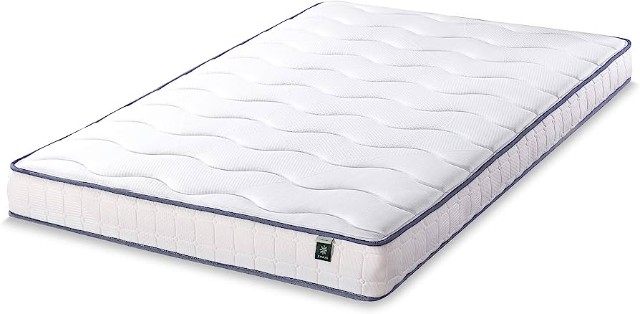
Hourglass-shaped coils form the service layer in this innerspring mattress. These coils would be the lowest priced one of spring mattresses, making these beds less lasting than other sorts.
Offset Coil Mattress
Individual coils are attached since they sit very tight and close, collectively forming a coil coating that provides firm support to the mattress. Offset coil mattresses are durable, but the attached coils move the motion, not creating a fantastic solution for couples.
Continuous Coil Mattress
Continuous coils include one massive wire twisted into tens of thousands of coils to make the service layer. Although this arrangement creates a highly durable mattress, it transports the movement because the whole support coating is well connected.
Pocket Coil Mattress
Pocket coils mattresses include innerspring coils separately wrapped in fabric. They’re the newest edition of coils and are technologically more sophisticated than others, making them the most expensive in the spring mattress group. The person wrappings reduce motion transfer considerably, which makes this bed among the preferred choices.
Coil-on-Coil Mattress
Two layers of coils are piled on top of one another to boost the aid in a coil-on-coil mattress. The further layer piled over the foundation layer reduces rebound and raises the support within this coil-on-coil mattress.
Check out Best Mattress Brands for Every Type of Sleeper: http://nousdecor.com/best-mattress
Foam and Spring Mattress Comparison
Both foam and spring mattresses have their advantages and disadvantages. Deciding that you select is not ‘black & white’ and comes down to your preferences. This includes how hot you are when you sleep soundly, which position you sleep in, and some other health problems you might have.
Memory Foam is synthetic.
Memory foam is a petroleum-based, synthetic material. Spring mattresses are made of steel coils from natural metals. Memory foam is made with a variety of chemicals and can be off-gas. Spring mattresses are entirely odorless.
Memory Foam retains heat.
Memory foam is known for trapping heat, making you feel hot and uncomfortable due to its sinkage and hug. A memory foam mattress is not suitable for hot sleepers. On the other hand, Spring mattresses keep your body’s temperature down because of the increased airflow through the coils.
Memory Foam Cushions & Conforms
Sleepers love memory foam for its comforting feel. It cushions pressure points like the hips and neck, relieving pain. Memory foam is excellent for side sleepers due to its excellent conformity. On the other hand, Spring mattresses lack conformed support, which may lead to pressure formation in petite sleepers.
Spring Mattress Supports Strong Edges
Spring mattresses have a coil structure that is interconnected, which provides stable edge support. Spring mattresses are safe for children and the elderly because of their structural integrity.
Memory foam mattresses have no edge support. It compresses rapidly under pressure and takes some time to return to its original form.
Durability
In regards to foam vs spring mattresses, durability will be a high priority. You do not wish to purchase a mattress that is only going to last a few years. Typically, memory foam mattresses have been proven to be more lasting due to deficiency of coils, which lessens the danger of sagging.
Spring mattress is quite durable, but they might not survive so long as foam mattresses. This is due to the springs and springs which are employed in their construction. As time passes, these springs might begin to feel as though they’re poking into you because of this fabric sagging.
Infection
While it’s true foam mattresses may trap heat, fresh cooling technology, such as gel, aluminum, and graphite infusions, extract heat in your system to promote temperature neutrality. Even without infusions, contemporary memory foam’s mobile structure fosters better airflow to regulate body temperature while keeping support.
Spring mattress is cooler than foam mattress because of their coil foundations. Air is practically unhindered inside the spring coating, which prevents the sleeper from overheating.
Bounce

Innerspring beds offer the best feel. Foam mattresses are more shock-absorbing. They return to their original position faster and feel more comfortable.
There are significant differences in the bouncinesses of foam mattresses. Foam latex is more responsive and bouncier than memory foam.
Scent
New foam mattresses may exude an unpleasant odor called off-gassing, which’s the discharge of volatile organic chemicals (VOCs) used during production. Mattresses made with plant-based foam do not emit as much off-gassing because the production process uses fewer dangerous chemicals.
On the flip side, spring mattresses do not frequently release scents, and hybrid mattresses that utilize spring and foam materials occasionally emit off-gassing.
Temperature Sensitivity
Temperature sensitivities between foam and spring mattresses can be vastly different. Your mattress’s temperature can be affected by the weather outside as well as the room temperature inside. Extreme temperatures can make this a critical feature.
The temperature neutrality of spring mattresses is a hallmark. Your body heat won’t affect the mattress’s temperature when you sleep on it. This is because heat doesn’t alter the coils’ feel, and b) air circulation keeps the coils cool.
Memory foam becomes soft as it heats up, and hardens upon cooling. It melts under your skin and hugges you for deep comfort when it comes into contact with body heat.
They can make you sleep hot, but mattress manufacturers today use many methods to keep them cool. Latex is temperature neutral and naturally cool, just like springs.
Preferences for Sleep Position
Different people sleep differently. Some people sleep on the back, while others prefer to sleep on their stomachs or sides. This is why the feel of the mattress and the support it provides for each type of sleeper are different.
Your comfort level will vary depending on the mattress material. Not every mattress is right for you.
Because of its ability to support your spine, a spring mattress is a popular choice for back sleepers. This reduces pressure in key areas, which relieves back pain.
Combo sleepers can also change their positions quickly without disrupting their sleep with the spring mattress.
Foam mattresses are popular with stomach and side sleepers because they conform to their bodies well. Foam mattresses allow your hips and shoulders to sink as needed, while your flank and thighs can be supported enough so that you have perfect spinal alignment.
Also, stomach sleepers love to rest on firmer foams as it provides them with the support and sinkage they need. They should steer clear of memory foam and soft foams that may compress their chests and make breathing difficult.
Back Pain Relief/Spinal Alignment
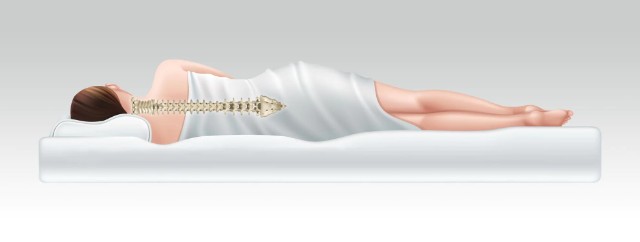
Poorly fitting mattresses can cause back pain and can even worsen existing aches. It is an important factor to choose a mattress that aligns properly with your spine and alleviates back pain.
Spring mattresses can be used to relieve back pain, particularly those with pocketed coils. Some spring units can offer less support or increase pain.
Spring mattresses are the most supportive for stomach and back sleepers, as they provide firm support.
Foam mattresses relieve back pain. The foam layers provide continuous support and help maintain healthy spine alignment.
Foams are great for relieving back pain because they cushion your spine arch and relieve pressure. Some foams, however, can make your back hurt more by sinking into the mattress.
Price
A traditional innerspring mattress is the most affordable if your main concern is your budget. If you are looking for a luxurious innerspring mattress with unique features and cushioned comfort, however, you should be willing to spend more.
Foam mattresses are often more expensive than spring mattresses due to their durability and comfort. A simple foam mattress can sometimes be found at a lower price. Latex mattresses are generally more expensive due to natural materials and many health and environmental benefits.
FAQs about foam vs spring mattress
What sort of mattress is perfect for your spine?
A medium-firm memory foam mattress provides pain relief and design without cultivating interruptions in service which may otherwise occur on an innerspring mattress.
Can it be better to get more coils at a mattress?
Mattresses with greater coil counts provide better physiological support and boost the mattress’s wellbeing. While shoppers must avoid mattresses with reduced spiral counts, finding a mattress using a suitable count is dependent upon the mattress dimensions.
- Full mattresses: require 300 around coils
- Queen mattresses: want 400 around coils
- King mattresses: want 480 around coils
Can it be better to get a firm or soft mattress?
Choosing a firm or gentle mattress will depend on your physique and sleep fashion. Typically, the very best mattresses for side sleepers are mild to moderate. Mattresses for back sleepers are usually medium to medium-firm.
Lightweight sleepers frequently prefer a gentle to moderate firmness, while plus-size sleepers typically desire a moderate to medium-firm mattress.
What mattresses do chiropractors recommend?
Typically, chiropractors advocate a medium-firm mattress. This firmness is tender enough to reduce pressure points close to the joints but firm enough to lessen extra sinking and spinal misalignment.
What mattresses are perfect for side sleepers?
Most side sleepers would rather have a soft to moderate mattress. These sleepers require adequate contouring and cushioning since the shoulders and hips tend to bear most of the body fat when a side sleeper. If the mattress is too firm, sore spots may grow close to these sensitive locations.
Foam vs spring mattress: What is the Right Choice for You?
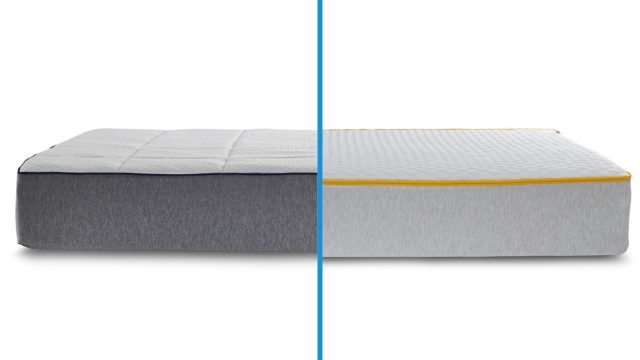
Foam is an excellent choice for those who want support and comfort mattress. The higher layers of foam are usually made with gels and soft foams.
However, the lower layers of foam tend to be high-density. This is an excellent alternative to an innerspring mattress. It allows for compression and alignment.
You can also add motion isolation and pressure relief to the list. This is excellent news both for couples and side sleepers. Hot sleepers, however, will need to choose between a foam mattress that has cooling properties or avoiding foam.
Although springs are the oldest type of mattress technology, their advantages in terms of support and ease of movement continue to be popular. Hot sleepers prefer innerspring mattresses with open cells to replace the foam, which is more likely to trap heat. However, springs are less comfortable than foam because their metal construction doesn’t hug the body.
It is up to you to choose the right type of mattress for you. Traditional innerspring mattresses are less popular than memory foam mattresses. If you are hesitant about buying one, you can still order a firm memory mattress to retain the comfort benefits.
Hot sleepers can also benefit from the same. We recommend looking at the various options that we have available, which include cooling memory foam mattresses.
Video:

